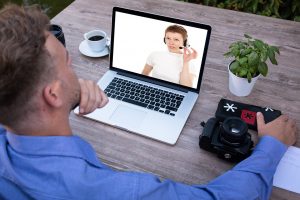Tips For Conducting Your Live Session
You can have a Live Session on campus, using one of the Live Session Studios in BIF; or you can do it in your office or from a remote location.
On-Campus: If you would like to do your Live Session on campus, in a classroom using classroom capture, you need to contact us at help@business.illinois.edu.
On Your Own: If you prefer to do the live session from your office, home or a remote location, there are few things to take care of as you go “solo”. Here some tips and advice to have a successful session with your students.
When Hosting a Zoom Meeting:
- Tip 1: Find a quiet, well-lit room with little to no background noise and no bright lights or windows behind you.
- Tip 2: Download the Zoom app from their website (https://www.zoom.us).
- Tip 3: Start the meeting via the Zoom app on a laptop or desktop computer (PC or Mac)
- Tip 4: Do not use a mobile phone or web browser to launch a meeting (if you can avoid it). Quality can be spotty and with the web browser, certain features are disabled (such as breakouts and polls).
The Physical Space
Make sure you have  the computer/tablet/external camera high enough. Even tipping the screen to a good angle it feels like we are looking up at you. If you can raise your machine up six inches it will cast you in a more appealing view.
the computer/tablet/external camera high enough. Even tipping the screen to a good angle it feels like we are looking up at you. If you can raise your machine up six inches it will cast you in a more appealing view.
- Make sure there’s adequate light in front of you.
- Make sure there are not any bright lights or windows behind you.
- Put some soft things under your computer position to dampen the sound (a towel, a piece of cloth, a
- Set up in a room with as many soft surfaces as possible – curtains, carpet, clothes/coats hanging. If it looks ok, pointing into a closet works amazingly well.
- Position your chair so you fill the screen with your torso from the bottom of the ribs up.
Check out this video about how to optimize your online brand
About Audio and Video
- While you can certainly run a Zoom session on a laptop using its integrated mic and webcam, this may result in poor quality audio and video. It is better if you wear a headset (like the ones from your phone) or you may buy a USB microphone specifically for videoconferencing. These can be plugged into a laptop’s USB port and give better audio quality than the one from your laptop which will pick up external noises as well.
- Once connected, you can test your audio in Zoom by clicking “Test speaker and microphone” to verify the microphone is working correctly. These microphones are plug-and-play; you do not need to manually download drivers to set them up. See Zoom’s Testing Computer or Audio page for more details on verifying microphone functionality.
- Please, if you don’t have a headset or special microphone, you need to get a pair of headphones for running a meeting, otherwise, there may be audio feedback (your speakers putting out audio that then accidentally feeds into your mic). Zoom does a good job of correcting for this but it is best not to rely on this.
Recommended Hardware
- A good standalone Microphone: Blue Snowball USB Microphone ($49)
- Recommended headsets for Zoom.